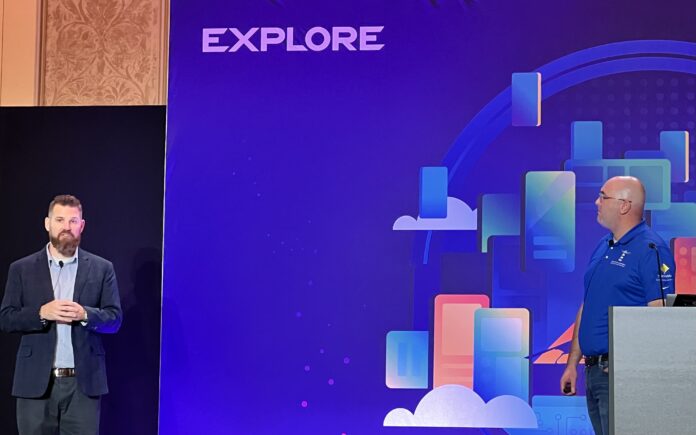Standardizing interoperable, open, secure industrial control architectures
LAS VEGAS–ExxonMobil has a vision for technology enablement marked by a long-term shift from closed IT and OT systems to open, secure, standards-based systems that promote value creation. A tricky problem unique to heavy industries, however, is that control systems have a long—think 20 to 30 year—lifespan. So the problem space, as laid out by ExxonMobil and VMware by Broadcom executives during a session at VMware Explore, is how to bring the programmability and upgradability and other benefits of modern IT systems in the OT world.
ExxonMobil IT Architect and Fellow Dave Hedge acknowledged his background in IT in talking through his current charge of helping the oil and gas giant “re-envision OT…[and] allow the business to move forward with technology rather than be stuck.” Whether for downstream or upstream environments, Hedge said the big goal is to develop a standardized blueprint that can be deployed in any type of facility; essentially, how to build an IT system with the flexibility to bring net new value into the harsh, varied world of the OT edge.
ExxonMobil, VMware by Broadcom and a host of other technology, system integration and industrial end users came together under the umbrella of the Open Process Automation (OPA) Forum, a group formed to “develop, publish and evolve an open architecture and specification support by industry end users, suppliers and integrators,” according the OPA Forum’s website. The resulting standard, O-PAS, “defines an open, interoperable, and secure architecture for industrial process automation systems, using existing and emerging standards whenever possible.”
Hedge detailed the OPA Advanced Computing Platform—what ExxonMobile is prepping to deploy at a plant in Baton Rouge, Louisiana—built in partnership with Dell Technologies, Intel, Schneider Electric, VMware by Broadcom, and Yokogawa. He called out six key pillars of the platform:
- App ready—multiple application architectures supporting process control, core services, and more
- Automated operations—high degree of automation for ease of operation
- Future extensibility—host for current and future AI/ML and advanced optimizations
- Industrial scale—hyperconverged and sized to business need
- Operational resiliency—orchestration and high availability
- Security design in—IEC-62443, O-PAS 2.1, event logging and alerts
On the security point, Hedge said, “OT is very, very specific around security…Historically what we’ve done…is we’ve had to bolt things on which works to some extent until you have too many bolts.”
Back to the OPA Advanced Computing Platform. Hedge said the v1 focus in 2019 was around interoperability, followed by a v2, in 2020, focused on configuration portability. Version 2.1 came in the 2021-2022 timeframe and looked at control functionality. And v3 came in 2023 (and continues today) with refinements around app portability and orchestration. Detailing the present state and the desired future state of the compute platform, Hedge said a reliance on common off the shelf (COTS) hardware and purpose-built hardware and virtual machines (VMs) managed by engineers and technicians will give way to primarily COTS hardware running VMs and containers and operated by technicians only. That future state will involve “cognitive functions” and be “close to self-driving.”
From the VMware by Broadcom point of view, Chris Mutchler, principal enterprise architect, said this was an attractive opportunity to work on an emerging technology area. Because of the lifecycle of OT systems, “there’s not a lot of opportunity for change,” he said. “The purpose of this was to make more and more of this programmable, easily swapped in and out, all of the things we’ve been doing in IT…for the last 20-plus years” and bring that into the OT space.
Mutchler called out the “massive cultural shift” that comes with embedding technology deep into operational environments and making it accessible, and valuable, to different skilled workforces. He also echoed Hedge’s emphasis on standardization to facilitate broad, rapid adoption. Referencing the upcoming deployment in Baton Rouge, he pointed out that everything being shipped there is available for sale today. “What we are doing, what ExxonMobil is doing…is possible today with no real heavy lifting…This is not about ExxonMobil and Vmware…We’re trying to build this as a community.”
Hedge said the field trial in Baton Rouge involves a complete replacement of existing distributed control system (DCS) and programmable logic controller (PLC) technologies. The new stack, he said, “looks like an IT system…[and] behaves like an IT system. That’s because it is an IT system, but it runs an OT workload.”
As for what he learned through this process, “Innovating takes a lot of time, and a lot of learning,” Hedge said. But with this container-based approach to OT, “We’re able to meet or exceed what the current existing system can do, and it’s all containerized which gives us a huge capability in terms of automation.”

